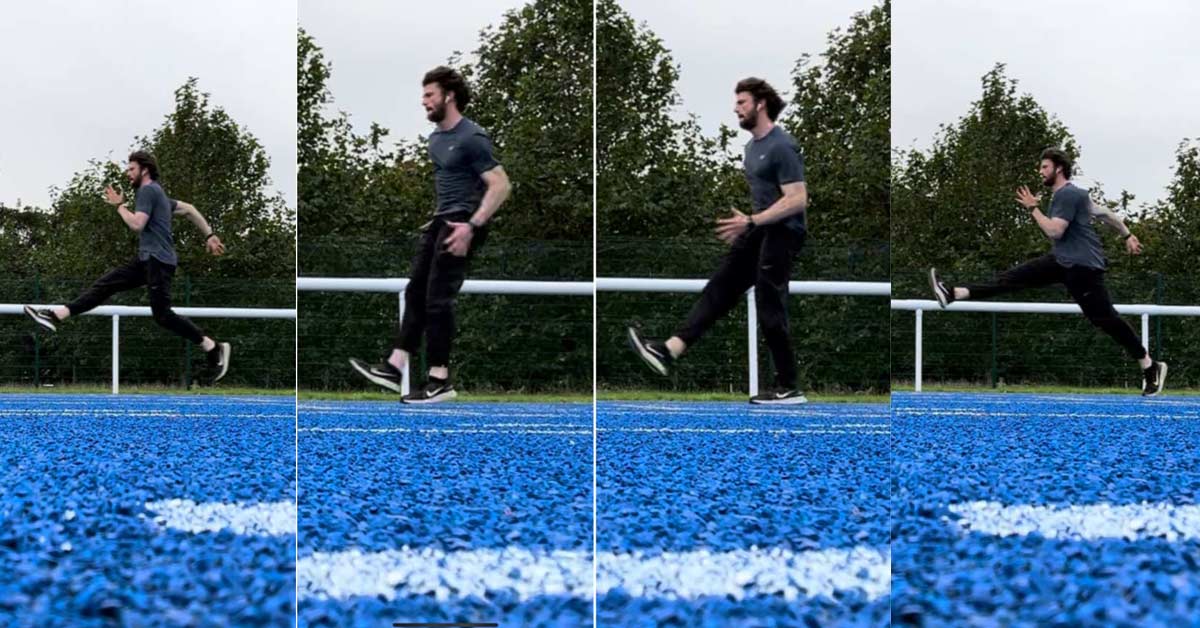How does an athlete go about increasing their speed and improving their sprint technique? The most common answer is drills, drills, drills, and then—guess what—more drills! But is spending an arduous amount of time at training, and even in the warm-up before a race, constantly drilling, really the best or only way to improve speed and technique?
Drilling is a genuine endeavor, and indeed, some drills have an effective influence on a sprinter’s max velocity and running form. However, I propose that dedicating a copious chunk of training time and the pre-competition warm-up to drilling is overrated and an over-allocation of time and energy. There are more effective remedies to improving the flaws of one’s speed and technique.
I propose that dedicating a copious chunk of training time and the pre-competition warm-up to drilling is overrated and an over-allocation of time and energy. Share on XI am a 20-year-old student-athlete from Melbourne, Australia, who has focused on and competed in the 400m as a junior. My biggest junior achievements:
- Making the State U16 400m final at the Victorian All Schools Track and Field Championships, placing seventh in 2019.
- Winning the 400m at the Stawell Gift in 2022—a professional handicapped athletics meet that occurs every Easter in northwest country Victoria.
For the next few years, I am making the 200m my primary focus, with the endeavor of improving my pure speed and speed endurance, eventually making the move back to 400m with my newfound speed.
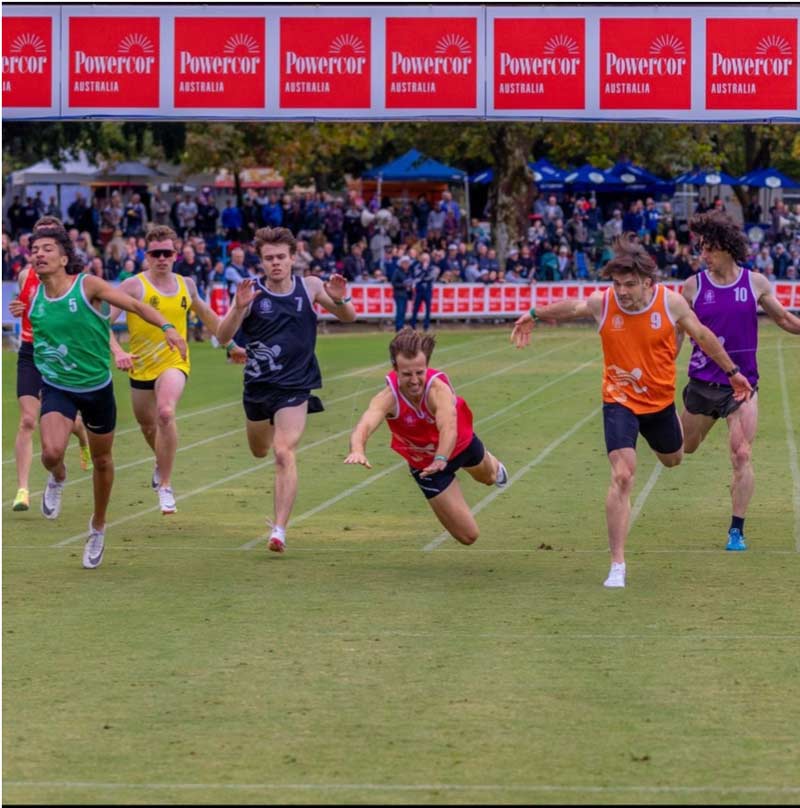
Now, at the beginning of 2024, with the goal of pure speed in mind and, thus, experimenting in different ways—including doing a copious number of drills—I have developed the personal opinion that drills are not always the golden solution to improving speed and technique they are often portrayed to be, given a lack of transference.
This isn’t meant to demonize all drills, as I do think some can provide a direct transference to max velocity sprinting. When done with high quality, they can directly influence a sprinter’s max speed-associated technique.
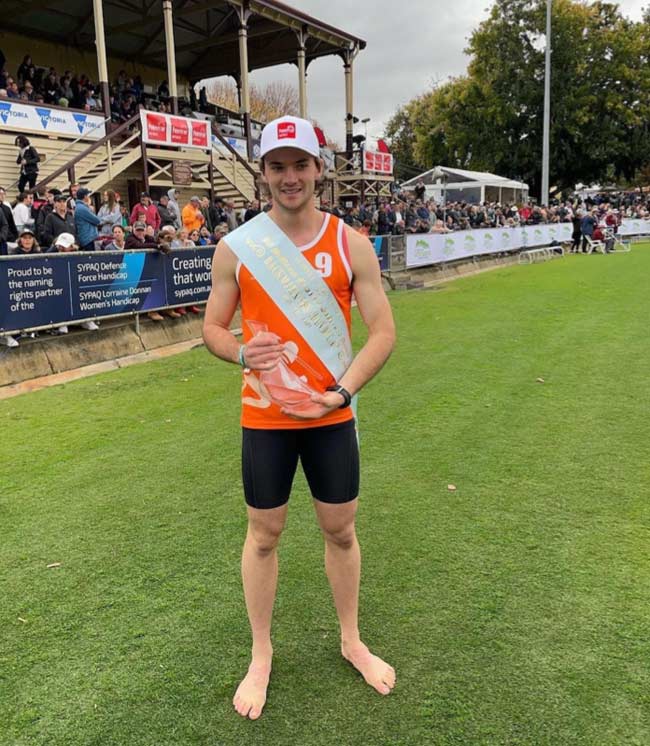
Training Movement Quality vs. Going Through the Motions
Drills are thought of as the best elixir for the problems of speed and technique that any athlete—amateur or professional, beginner or advanced—faces when aiming to improve. The general consensus is that “slowing things down” and isolating the necessary areas of improvement via a specific drill will be the best solution to highlight, amend, and eventually put the athlete in a new movement pattern and on the correct course for improvement.
Some examples:
- An athlete may be planting their foot too early pre-ground contact. A variety of dribbling drills—i.e., ankle/knee dribbles—are administered, guiding them away from early plantar flexion and encouraging a more neutral and active foot strike, with the ultimate aim of utilizing the huge elastic qualities of the calf complex.
- Similarly, if an athlete has lagging backside mechanics, “butt kicks” are administered to develop a more efficient leg recovery, improving leg cycle and increasing stride frequency.
Although drills are indeed effective and wonderful for putting specific areas of sprinting into context to improve the athlete’s comprehension of the necessary areas of improvement, athletes and coaches spend too long on drills. Consequently, they do not make the most of training and slow down their rate of improvement.
Athletes and coaches spend too long on drills. Consequently, they do not make the most of training and slow down their rate of improvement. Share on XToo often, with beginners—or even high-level sprinters already progressed in their careers—coaches point out flaws in their technique when striding or sprinting at 100% max velocity. A quick fix? A long list of drills. For most athletes, these drills are too general, often done either in their training warm-up or before a competition.
Unfortunately, the athlete just goes through the motions with the drills, never having the presence of mind to focus on the necessary areas of improvement. What does it mean for an athlete to go through the motions? It simply means that they complete their warm-up, which remains the same (however necessary to modify a warm-up in training, given a change in the necessary areas of improvement), as if it is a checklist. They view their drills as something they have to do and not something they get to do.
Therefore, it is as if they resent having to do their drills, diverting their attention to the birds in the sky or other people on the track, as opposed to locking in, feeling the movement pattern of the drill, understanding it, and when done, asking themselves how they could have completed the drill better. As such, new athletes do not develop and become rather stagnant and unmotivated to keep persevering in an already frustrating sport. Higher-level sprinters, meanwhile, do not continue their improvement, being unable to conquer the plateau on which they find themselves.
Furthermore, as a consequence of athletes being too conscious of executing the drill correctly and simply going through the motions, drills are simply not effective and influential enough to translate their benefit into 100% max velocity sprinting, where the athlete is not (and should not be) thinking about technique cues and their running flaws. Therefore, it is logical to deduce that drills, especially the universal drills all coaches can easily chuck at athletes (A-skip, B-skip, C-skip, etc.), are not powerful enough to exert real, visible, and tangible changes to an athlete’s running technique and, thus, their speed, which is reflected in an improvement in their running times.
Remember, speed is a skill, and it can absolutely be manipulated for the better, regardless of an athlete’s ‘’natural talent” (which is useless if they are not willing to work), as well as the profound ability of their muscles and tendons—and most importantly for sprinting, their central nervous system—to respond greatly to the training stimulus placed upon it.
Two Drills That Move the Needle
Drilling can be effective at putting specific technique cues into context, but they are not the only solution. Therefore, due to the sheer adaptability of the human body, brain, and nervous system, what are productive remedies to improve an athlete’s technique and speed? Well, there are two solutions: one path is “modified” running, and the other is very specific running drills that closely simulate special areas of max velocity sprinting. When done correctly, these drills are executed at a high enough level of intensity for a true transference to take place, where an athlete will absolutely see and feel an improvement in their performance.
The two drills that have the best chance to transfer benefit are straight leg bounds and the single *fast leg* drill. Share on XThe two drills that have the best chance to transfer benefit are straight leg bounds and the single *fast leg* drill. Why? Well, they most closely resemble the running cycle at maximum velocity and, when performed correctly, are close enough in intensity to 100% sprinting.
So, what are the benefits of these two drills?
1. Straight Leg Bounds
This exercise puts into context arguably the most crucial aspect of max velocity sprinting: at top speed, the majority of the forces produced by the sprinter are vertical, not horizontal; an athlete must exert a huge amount of vertical force under their center of mass, in as little time as possible; and there is almost no horizontal force or pushing at all. So, what does this look like?
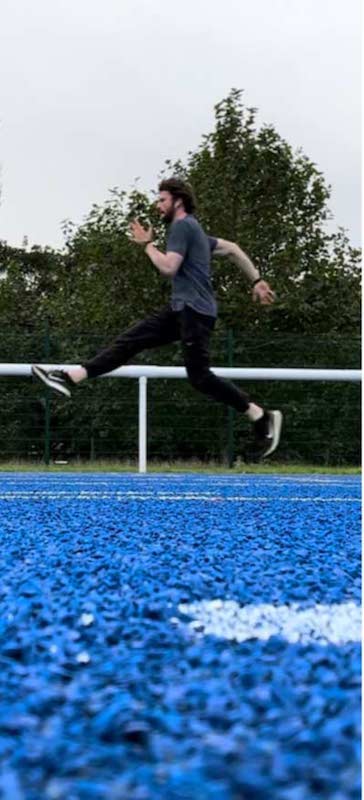
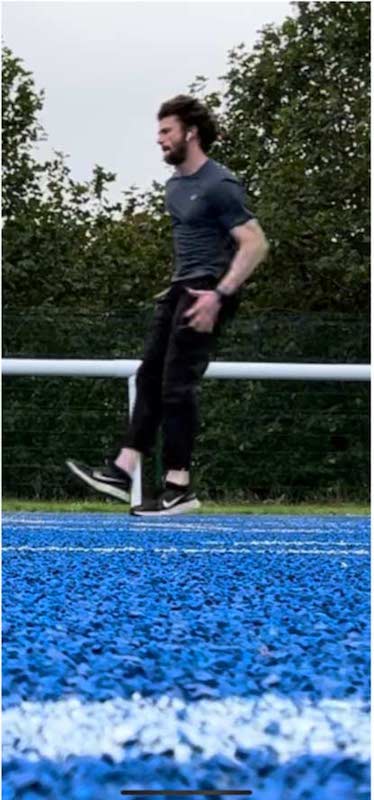
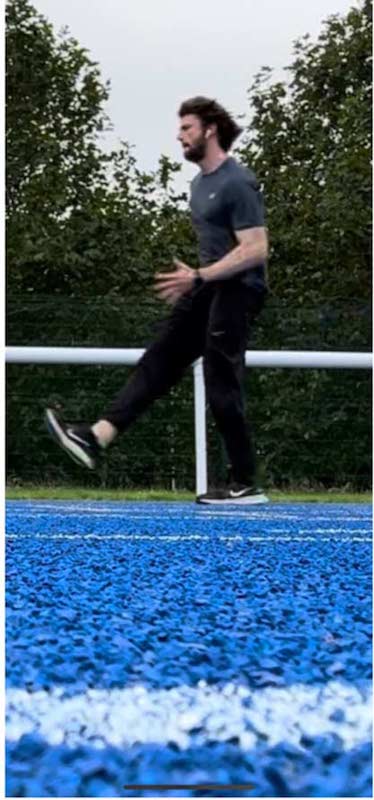
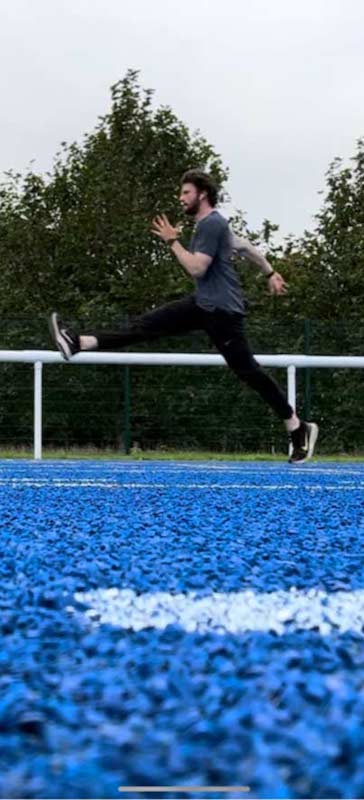
When performing straight leg bounds, an athlete learns when to apply force and push (vertically) and when to take their leg off the ground or “ease off.” If aiming to go for distance by trying to “brush” the ground like one would if they were trying to speed up on a scooter, the athlete would lose a significant amount of vertical force, as they would have begun pushing horizontally, putting in too much effort to produce speed for distance. Moreover, they would lose their leg stiffness (the knee should be almost locked out, and the leg movement should come from the hip). Also, braking forces would occur, where the athlete would stumble or even fall over.
I have certainly experienced this myself. Refer back to image 6 of the straight leg bound, the toe-off phase, where, if overstriding continued, the foot would remain flat on the ground, continuing to apply force behind the center of mass, spending too much time on the ground and acting as an anchor, which will limit the athlete’s horizontal velocity. Remember, for the drill to transfer, the athlete must maintain leg stiffness, delivering a huge amount of vertical force in a punch-like manner in as little time as possible.
The athlete should keep in mind that straight leg bounds are most closely related to a modified form of running and not bounds for horizontal distance. Although classified as a drill, the athlete must carry out the drill with max speed velocity and, moreover, quick and powerful vertical force application in mind, as opposed to just trying to cover as much ground as possible with each foot strike.
Furthermore, straight leg bounds are amazingly effective at putting the athlete in the correct foot strike position—maintaining the dorsiflexion position (toes pointed up) right until the very last minute, where the athlete plants their foot to produce a huge amount of vertical force in the first half of ground contact. The best sprinters look like they are almost running flat-footed, as they are extremely good at applying force via a very last-minute plantar flexion. Straight leg bounds rely on the athlete’s elastic qualities, which are more important than the muscular qualities of an athlete at top speed and, therefore, are highly beneficial for improving an athlete’s elasticity in a practical manner that most closely resembles max velocity sprinting.
Lastly, straight leg bounds are the most practical drill given that it is possible to start bounding and then instantly transition into max velocity sprinting, with the aim of maintaining the elastic forces produced from the bounds and correct running technique cues, i.e., correct foot strike and leg stiffness, for genuine transference.
2. Single Fast Leg
The isolation of one leg is extremely beneficial for athletes because it forces them to focus on quickly picking the leg up and ripping the leg back down efficiently while the swing leg is performing a supporting mini straight leg bound. Some of the ways athletes can perform it are:
- 3×6 each leg
- 2×9 each leg
And either:
- a focus on backside mechanics: quick and high leg recovery/fast leg turnover
or
- a focus on frontside mechanics: fast negative foot speed, vertical force application under COM.
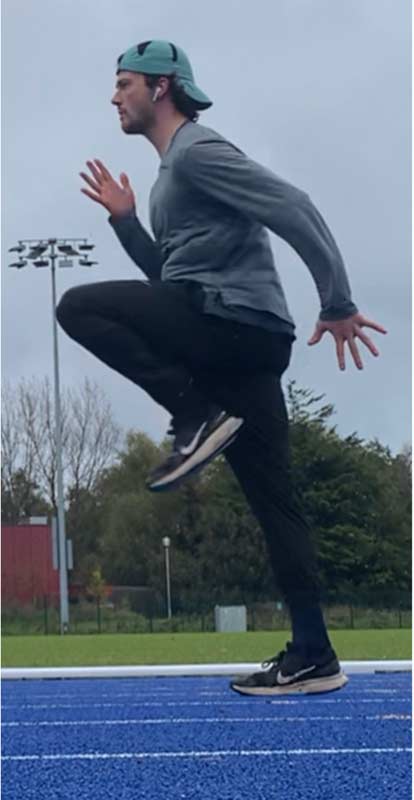
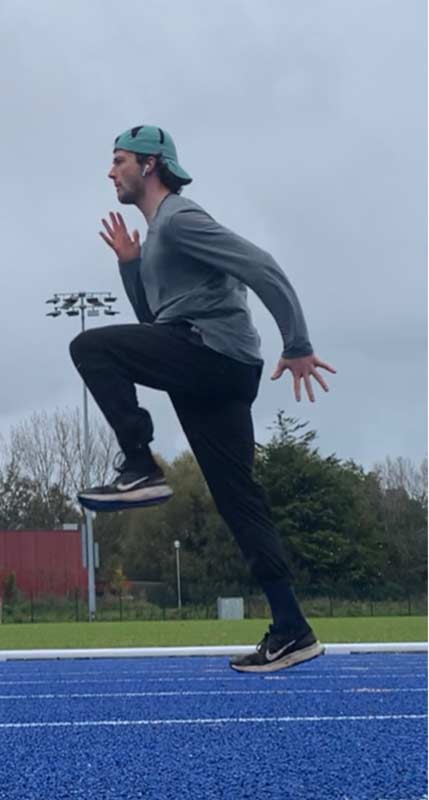
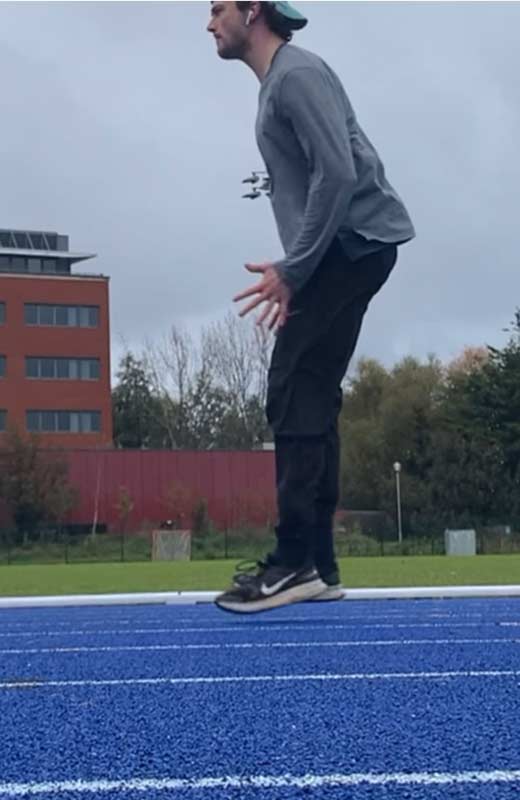
Many athletes struggle with a fast, high heel recovery, which limits their potential to have both knees together at initial ground contact (the bare minimum to be able to sprint at a high level). Optimally, the athlete should have their leg recovery straight through under their body and effectively into the “killer” high knee position, where hip, knee, and ankle joints are at a 90-degree angle.
From there, while performing the drill, the athlete can practice the concept of “whip from the hip.” For this, the athlete rips/swings their leg backward, attempting to apply a huge amount of force under their center of mass, where inevitably, the vertical force produced will translate into horizontal velocity. The single fast leg drill is really a “two birds, one stone” scenario, allowing the athlete to practice a fast and high leg recovery—ideally heel to glutes, with the recovery ankle being higher than the stance leg knee—as well as apply a considerable amount of force when the leg is out in front.
Specifically, single fast leg also allows the athlete to develop their elastic qualities, which will enhance top speed and improve neuromuscular coordination with regard to being better able to switch on the extensor and flexor muscles (i.e., knowing when to utilize the hip flexors to raise the leg into the high knee position quickly). Additionally, the drill helps develop the sense of when to utilize the hamstrings and glutes to create negative foot speed to produce vertical force.
An increase in neuromuscular coordination will gradually and inevitably translate into better technique and a higher max velocity. Like straight leg bounds, it is also possible to do single fast leg drilling and transition into upright max velocity sprinting while keeping and maintaining the desired running technique, allowing a transference of proper technique and amendment of technique flaws.
Taking It to the Track with No Arms?
After the execution of both drills, gradual transference is necessary. The most effective avenue to take would be to first do straight leg bounds, then single fast leg, and then follow those with no arms running. The name obviously implies that the athlete sprints without the use of their arms (ideally, hands on hips) at a high intensity.
These two drills have provided the most benefit and transference, especially when done in this order: straight leg bounds, single fast leg, then straight into no arms running. Share on XWhat this does is build a bridge between the recently completed drills and the eventually undertaken faster strides and the actual session. No-arms running is extremely effective and beneficial, given that it grabs the benefits from both drills and enables the athlete to enhance them into one single exercise/form of running:
- High heel recovery, high knee lift, vertical force application, knees just past each other at touchdown, and high stride frequency are made all the more familiar for the athlete while undertaking no arms running (ideally 3–4 reps over 30m–50m).
- Later, faster strides should be completed to feel and see improvement in their technique execution and, eventually, top speed.
As a young athlete endeavoring to improve my speed and power, and through much exploration and experimentation, I have found the two drills have provided the most benefit and transference, especially when done in this order: straight leg bounds, single fast leg, then straight into no arms running.
The benefits have been exponential, seeing and feeling plenty of improvement in a short amount of time. Many athletes hit plateaus in their training, and many cannot pull themselves out of the hole. I hope this article and some of the proposed solutions can encourage and help athletes who are finding it challenging to improve and those who feel stagnant.
Since you’re here…
…we have a small favor to ask. More people are reading SimpliFaster than ever, and each week we bring you compelling content from coaches, sport scientists, and physiotherapists who are devoted to building better athletes. Please take a moment to share the articles on social media, engage the authors with questions and comments below, and link to articles when appropriate if you have a blog or participate on forums of related topics. — SF

